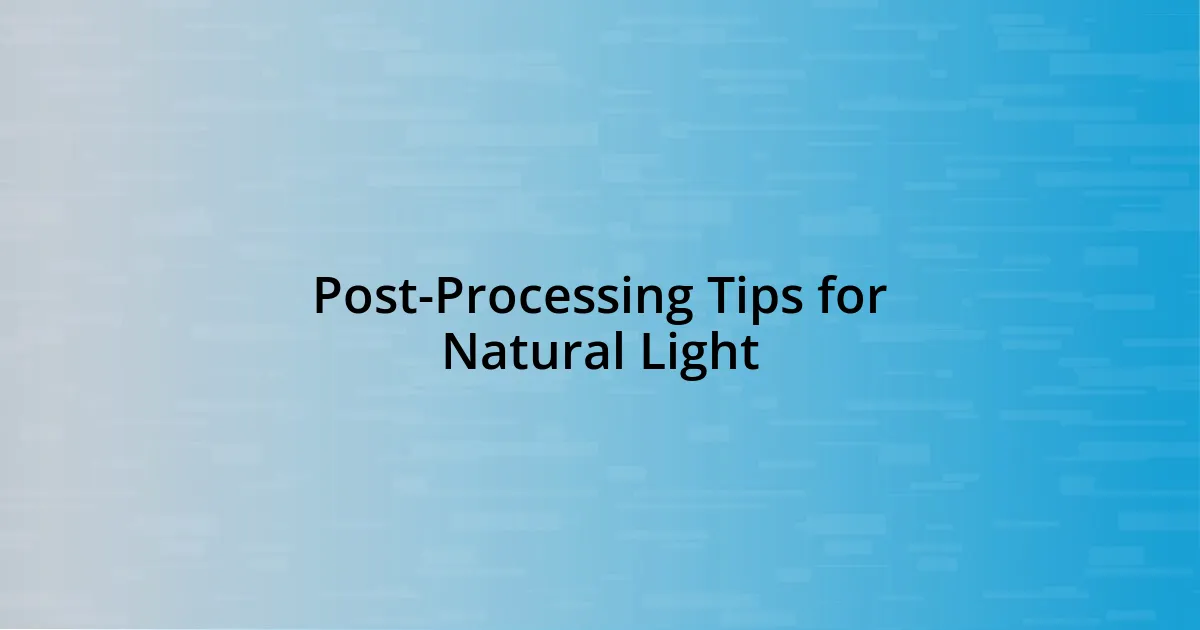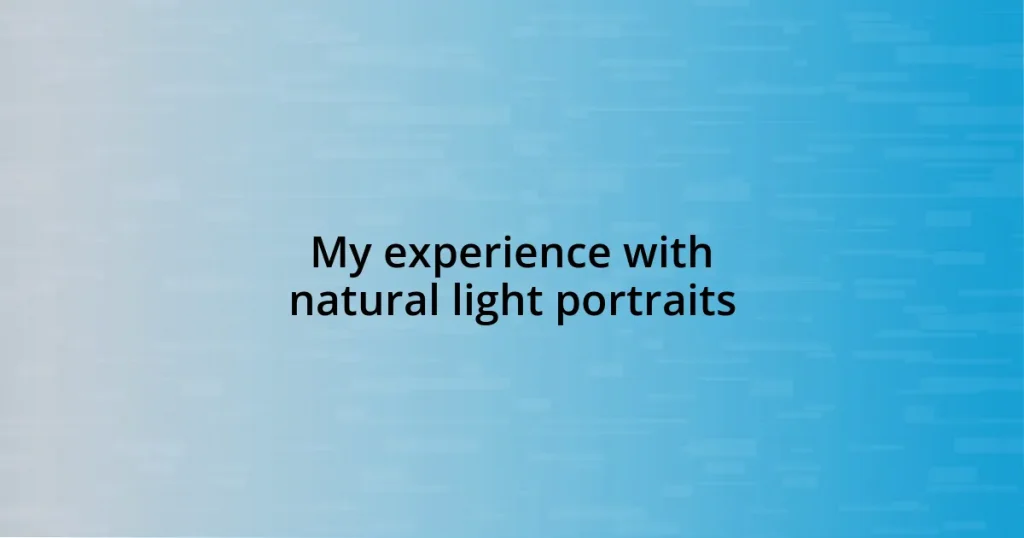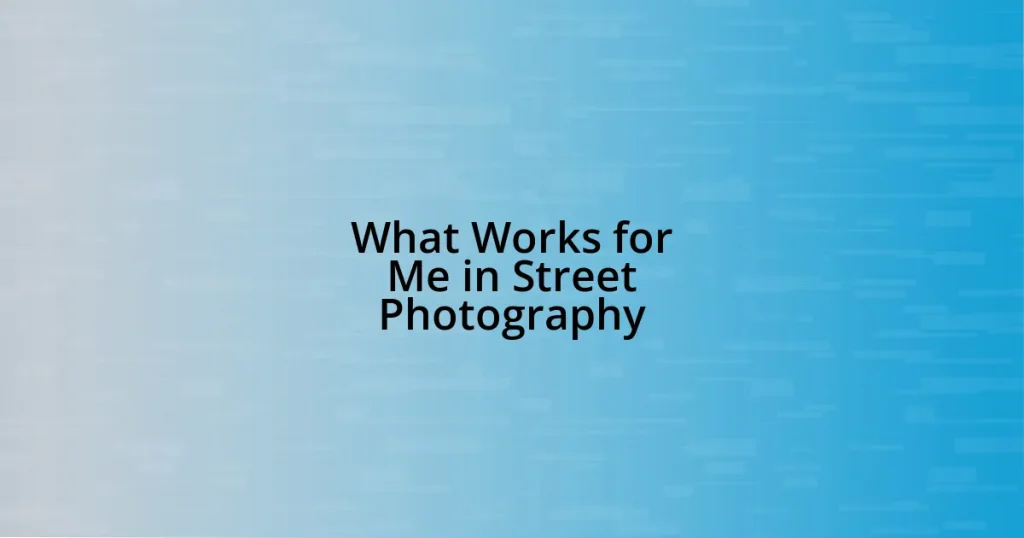Key takeaways:
- The golden hour and soft light create warm, flattering portraits, enhancing emotions and details.
- Location selection impacts the portrait’s narrative; consider backgrounds, light sources, and personal connections.
- Camera settings such as aperture, shutter speed, and ISO are crucial for capturing natural light effectively.
- Post-processing techniques like exposure adjustment, color correction, and dodging and burning enhance the final image.

Choosing the Right Time
When it comes to natural light portraits, timing is everything. I’ve found that the golden hour, just after sunrise or before sunset, infuses images with a warm glow that’s hard to replicate. Who doesn’t love that soft, flattering light that dances across the face?
I remember one shoot that took place right at sunset. The sky was painted in hues of orange and pink; it felt almost magical. I didn’t just capture the moment; I felt it. That particular glow enhanced the emotions I was trying to convey, making the portraits deeply resonant. Have you ever noticed how different lighting can completely change the mood of a photo?
Midday sun can be a tricky beast, too. The harsh shadows it creates can make details disappear, or worse yet, wash out the colors. I’ve shot in that blazing light before, and let me tell you, it took a lot of creativity and patience to make it work! It’s moments like these that remind me to be intentional about my timing and to seek the right conditions.

Understanding Natural Light Characteristics
Natural light holds unique characteristics that can make or break a portrait. One of the most fascinating aspects is the direction of light. I’ve noticed how light coming from the side creates beautiful textures and shapes, giving depth to the image. A recent portrait session, where my model stood next to a window, revealed how the side light not only highlighted her features but also cast lovely shadows that added drama.
The quality of light is equally important. Soft light, like that during overcast days, wraps around subjects gently, leading to smooth skin tones. I vividly recall capturing a portrait on such a day, where the clouds acted as a natural diffuser. It was as if every imperfection melted away, and the result was stunning. Have you ever wondered how these qualities could impact your own photography?
Lastly, the color of light shifts throughout the day and plays a crucial role in setting the mood. Morning and evening light often have warmer tones, while midday light tends to lean towards cooler hues. I had a particularly striking experience during a golden hour shoot, where the warmth literally felt like a hug, enriching the image with a sense of nostalgia. This contrast in colors reminds me to always pay attention to the time of day when planning a shoot.
| Light Characteristic | Impact on Portraits |
|---|---|
| Direction | Creates depth and texture; side light enhances features and drama. |
| Quality | Soft light smooths imperfections; hard light creates shadows and contrast. |
| Color | Warm light evokes emotions; cooler light can create a subdued mood. |

Selecting the Best Locations
Selecting the ideal locations for your natural light portraits can transform your work from good to extraordinary. I often wander through parks, urban spaces, and unique backdrops to pinpoint what speaks to me. There’s something exhilarating about discovering a spot where the light falls just right, and everything seems to align. During one memorable shoot in an old alley, the light bounced off the walls and created this stunning interplay of shadows. I could feel the location igniting creativity within me; it was like each corner had a story waiting to be told.
Here are some factors I consider when selecting locations:
- Variety of Backgrounds: Different textures and colors can enhance the portrait’s narrative.
- Proximity to Light Sources: Look for areas where light enters, such as windows or open fields.
- Time of Day: Consider how the position of the sun affects the space; it can drastically alter the mood.
- Weather Considerations: Overcast days can soften shadows, while bright days might necessitate shade.
- Personal Connection: Locations that resonate with your subject can infuse the portraits with more emotional depth.
Each location can lend a distinct personality to your photographs. Always trust your instincts; if a place speaks to you, it’s likely to create magic in your art as well.

Preparing Your Subjects for Portraits
Preparing your subjects for a portrait session is pivotal to capturing their true essence. I often spend a few minutes just chatting with my models, easing any nerves they might have. Do you remember feeling awkward in front of the camera? By engaging in conversation, I find that their genuine smiles emerge, and I can capture moments that are lively and authentic.
It’s also essential to discuss poses and expressions before we start. I like to encourage my subjects to think of a favorite memory or something that brings them joy. This simple technique often turns stiff postures into relaxed, natural ones. In one instance, I asked a young girl to think about her pet during our shoot. The joy in her face when she smiled about her dog was nothing short of magical; capturing that moment was truly rewarding.
Finally, I always remind my subjects about the importance of clothing choice. I’ve learned that solid colors often work better than busy patterns, as they keep the focus on the person rather than their outfit. During a recent shoot, my subject wore a bright red top that not only complemented her skin tone but also helped her stand out against a muted backdrop, enhancing the overall vibe of the portrait. What colors resonate with you? Choosing the right palette can significantly elevate your subjects and create a deeper connection within the images.

Camera Settings for Natural Light
When shooting natural light portraits, I find that the right camera settings can make all the difference. I typically opt for a wide aperture, usually around f/2.8 to f/4. This setting beautifully blurs the background, allowing the subject to pop while creating that dreamy bokeh effect. It’s always a thrill to watch how this simple change transforms an ordinary scene into something enchanting.
Shutter speed is another crucial factor. If I’m capturing candid moments as my subject interacts with their environment, I often set it to at least 1/200 of a second to freeze any motion. I remember a shoot in a sunlit park where a young boy was running toward his mother. With that shutter speed, I captured a moment of pure joy on his face, perfectly crisp amidst the blur of movement. Have you ever lost a precious moment because of a slow shutter speed? It’s a feeling I strive to avoid.
I also recommend adjusting the ISO based on the lighting conditions. On bright days, I keep it low at around 100 to maintain image quality. However, during golden hour, as the sun dips below the horizon, I might boost it to 400 or even 800 for that warm, inviting glow. During one sunset shoot, I cranked up the ISO, and the resulting warmth wrapped the subject in a cozy light that just felt like home. It’s these little adjustments that invite personal touch into my work and breathe life into the portraits I create. What adjustments will you make to capture your vision?

Techniques for Enhancing Skin Tones
When it comes to enhancing skin tones in natural light portraits, the direction of light is something I constantly consider. I often prefer diffused light, like on an overcast day or in the shadow of a building, which softens the harshness and creates a flattering glow on my subjects’ skin. Reflectors can also be a game changer; I once used a simple white reflector during a midday shoot, subtly bouncing light onto my subject’s face, which brought out a beautifully even tone. Have you ever noticed how a little bit of reflected light can brighten up a portrait?
Another technique I like is adjusting white balance during the shoot. In my experience, using a slightly warmer setting can add a touch of warmth to the skin tones, making them look vibrant and alive. One time, I opted for a custom white balance setting during a golden hour session, and it did wonders for my subject’s complexion, enhancing not just the skin tone but the overall mood of the portrait. What are your thoughts on the effect of white balance? It’s fascinating how such small tweaks can have a significant impact.
Lastly, I often pay close attention to the clothing choices my subjects wear, as certain colors can help enhance their natural skin tones. During a shoot, a friend wore a soft lavender top that beautifully complemented her golden undertones. The combination not only made her skin glow but also made the images feel cohesive. I believe in the power of colors to evoke emotions; have you ever played around with contrasting hues? It’s a creative exploration that can dramatically elevate a portrait’s visual appeal.

Post-Processing Tips for Natural Light
Post-processing is where I feel like the magic of natural light portraits truly unfolds. I usually start by adjusting exposure and contrast to enhance the mood of the image. For instance, in a recent portrait shoot during sunset, I found that boosting the shadows made a soft, inviting warmth shimmer across the subject’s face, turning a lovely moment into something almost ethereal. Have you ever noticed how just a slight lift in contrast can bring a portrait to life?
Color correction is another vital step. I prioritize ensuring that the hues reflect the vibrancy of the moment I captured. During a shoot in a flower garden, there were rows of vibrant blooms; I applied a slight saturation boost to the green foliage, creating a stunning backdrop that complemented the subject’s attire perfectly. It’s fascinating how the background can elevate the focal point of the portrait. Have you ever played with color tones and noticed how they shift the feel of your images?
Lastly, I recommend using dodging and burning techniques to draw the viewer’s eye to specific areas of the photo. When I experimented with this in a recent session, I selectively lightened my subject’s face while subtly darkening the background. The result was a striking focus on her expression, making it resonate even more. Have you tried this method? It can turn an already strong portrait into something truly unforgettable.
















